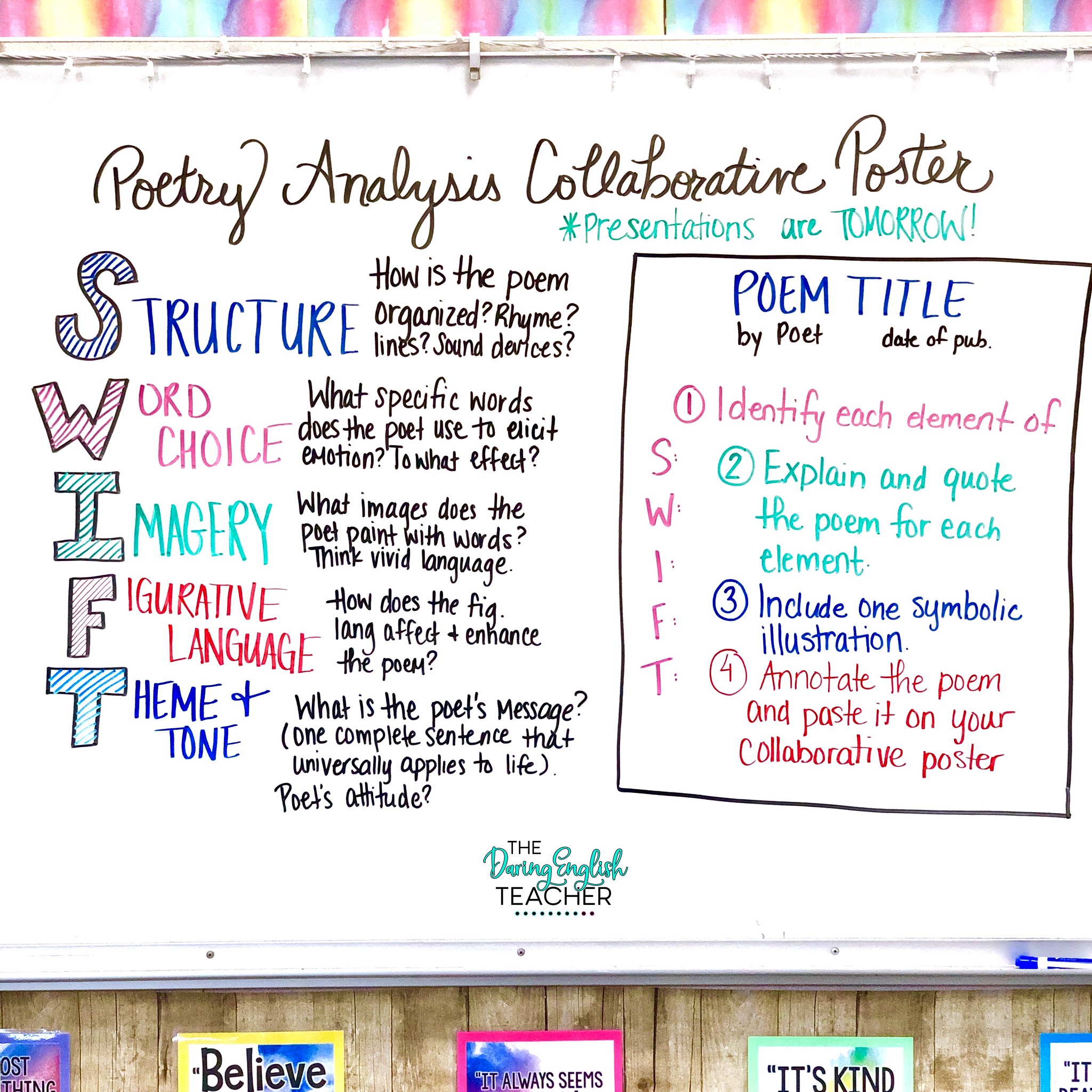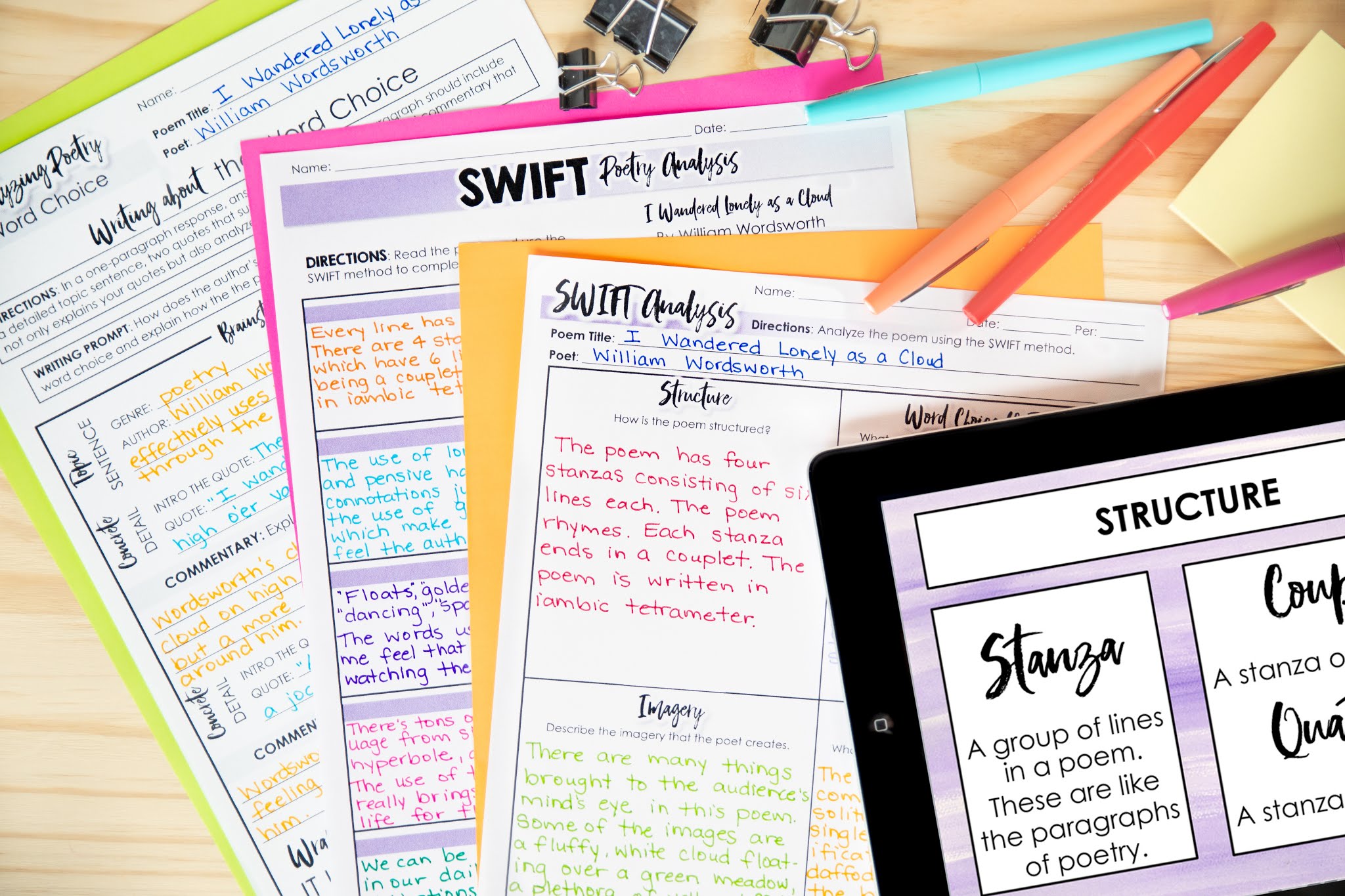If there’s one genre that intimidates students, it is definitely poetry. Poetry, for some reason, can make students shrink with uncertainty, doubt, and fear before you even begin the unit. However, this collaborative poetry analysis poster project is one that you and your students will absolutely LOVE!
When I teach poetry in my classroom, I first like to introduce students to it by teaching them how to read and annotate poetry. By breaking this process down for students, it immediately becomes less intimidating.
Once my students have a grasp on how to read poetry, I then throw them into the deep end with poetry analysis. When I teach analysis in my classroom, I use this poetry teaching unit that employs the acronym SWIFT to help students analyze one element at a time.
SWIFT stands for Structure, Word choice, Imagery, Figurative language, and Theme and tone.
Structure
When students analyze the structure, I have them look at how the poem is organized. First, they take a look at it visually and note what they see. Then, I have them look a bit closer. They look at lines and stanzas and rhyme scheme. They identify what type of poem it is. Furthermore, I like to include sound devices in structure because, like rhyme scheme, they were purposefully included for how they sound.
Word Choice
For word choice, I have students look at emotionally-charged and powerful words. This is also a great time to include a little lesson on connotation. We discuss how certain words carry more emotional meaning and why poets might choose those words over others. I always circle back to word choice when we are talking about tone.
Imagery
When students analyze imagery, I have them first imagine what pictures come to mind when they read the poem. Then, I have them go in and find the vivid language that appeals to the senses. Many times, students will see that figurative language and imagery are closely tied together.
Figurative Language
Analyzing figurative language is pretty straightforward. However, it is always my goal to have my students do more than just locate the figurative language in the poem. I want them to find it, identify it, explain why the language is figurative, and then be able to discuss what impact the figurative language has on the audience.
Theme/Tone
For theme and tone, I have students think about the message the poet is sending to the audience. For the theme, I want my students to come up with a statement about life that can be applied universally to people across the generations, races, sexes, and even time periods.
Once my students have a basic understanding of this acronym, which is usually after we analyze a couple of poems together as a class, I have them move forward and complete a collaborative poetry analysis poster project. Or in other words, my students work together in groups to put all of their analysis onto chart paper. Then, they present their posters to class.
After presentations, we have a gallery walk, and then we use the posters as a group brainstorming activity that I later turn into an analysis paragraph assignment. This, of course, takes place throughout a week.
The Poetry Analysis Collaborative Poster Project
For the poster project, I provided my students with directions on the whiteboard (see picture below). They had a little more than a class period to read a new poem, work together, and compile all of the required elements. I provided each of my student groups with a large piece of paper that I cut from a roll like this (Amazon link). Then, they get to work.
 As my students are completing the project, I walk around the room and monitor their progress. Whenever I circulate throughout the room, I usually hear my students engages in amazing conversations about poetry analysis. It is quite remarkable.
As my students are completing the project, I walk around the room and monitor their progress. Whenever I circulate throughout the room, I usually hear my students engages in amazing conversations about poetry analysis. It is quite remarkable.
Also, I use this time during the class period to do some quick, informal assessment. I can easily see which students understand the concept, and which ones do not.
For the kids who seem to be taking a backseat in the project, I assign them one of the letters from the acronym and help them work through the analysis. This way, I am ensuring that everyone (or at least, almost everyone) is engaged and learning in this activity.
This collaborative poetry poster project is a great transition activity to lead your students from whole-class instruction to independent analysis.
Working collaboratively with their peers allows them to talk through their poetry analysis as they gain confidence in this area of study. Furthermore, it is a way to help struggling students because they will get to see the stronger students in their groups model out loud a somewhat different poetry analysis approach that I taught.




